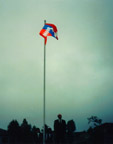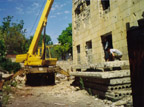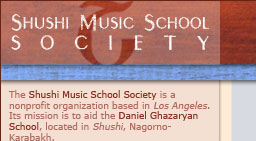Foundation of Shushi Music School Society
Since its inception by a group of visionary Armenians, on April 12, 1994, the Shushi Music School Society has worked relentlessly to support the Daniel Ghazaryan School. Located in the heart of Nagorno-Karabakh, this institution was established to stimulate the cultural reawakening of the ancient city of Shushi. The founding members of this non-profit organization, officially recognized by the Republic of Nagorno-Karabakh in 1994, firmly believe that the future graduates of the Daniel Ghazaryan School will play a key role in achieving this goal.
Daniel Ghazaryan School: How it all Began...
In 1994, the Mayor of Shushi donated three war-damaged buildings to the Daniel Ghazaryan School. Instruction and performances take place in the largest of these three buildings which serves as the main school building. This main building is three stories high, with 34 classrooms, a concert hall, a |
 |
| sports hall, a fully equipped cafeteria, and a main entrance hall. |
The other two buildings are designated as living quarters with a capacity to house 200 students. The living quarters, which are still under construction, are five stories high and will be equipped with full amenities, to provide the much-needed tranquil living conditions for the children of Nagorno-Karabakh and neighboring regions who chose to reside on campus.
On September 7, 1997, the Daniel Ghazaryan School began its first academic session with 35 students, following an official opening ceremony. Speakers at this ceremony included government dignitaries from the Republic of Armenia and Nagorno-Karabakh. The ceremony also featured poetry recited by the students. And for the first time in the history of Shushi, the new flag of the Republic of Nagorno-Karabakh was raised as the students performed the Republic's anthem. |
 |
Establishment of Daniel Ghazaryan: A Long and Arduous Journey.
Observations of Garen Garibyan, Founding Member of Shushi Music School Society:
“When I visited Shushi in 1993, there was nothing left but ruins of a once beautiful and culturally thriving city. |
 |
Once we started the preliminary preparations in 1994, we realized what a monumental and unbelievably difficult task we were faced with. The only road via Lachin to Armenia was in terrible shape and quite dangerous to drive through. There was no electricity or fuel. The city’s location on a mountain top further complicated the task ahead. |
 |
| In addition, the only equipment available was a heavy duty truck and a crane. |
Our first project was to transport cement to Shushi. This, we accomplished by utilizing four cement trucks from Armenia. At that time, the Yerevan-Shushi trip was normally a ten hour drive. It took three cement trucks three days, however, to complete this trip. Meanwhile, a fourth truck was lagging behind by a full day due to continued bombings along the stretch of that road.
There were very few helping hands along the way. Shushi, a city once inhabited by 30,000 people, was now home to only 3,000, most of whom were women, children, elderly citizens, and disabled soldiers. We therefore had to extend our search for laborers to the neighboring cities of Goris, Sisian, |
 |
| and Yeghegnadzor. Workers would often come and work for a month and then leave for various reasons. Everything was done manually: hauling the cement, stones, and sand up to the third floor of the building and mixing them with water on site. Since winters are quite harsh in Shushi, construction could only take place from April to October. |
By winter of 1995, the three roofs of the main building were completed. Shortly thereafter, construction slowed down to a crawl when funds were exhausted and donations became scarce. Meanwhile, inflation was driving the cost of building materials higher and higher. We were therefore forced to stop construction several times until funds became available again.
Finding building material was yet another challenge. In 1997, we arranged for the transport of window glass, valued at $3,000, from Iran via the bridge of Meghri. With help from the United Armenia Fund, $3,800 of plumbing material was also shipped to Karabagh from Los Angeles. It was through the same channels that we were able to send $18,000 worth of new and used carpentry machines to Shushi. These machines provided great savings because building materials and classroom furniture could not be built on site.
In September of 1997, the renovation of 16 classrooms in the main building of the school was completed. Daniel Ghazaryan opened its doors to its first class of 35 students. The second class began to attend the school in 1998.”
in 2008, fifteen specialist-inspectors from NKR, Ministry of Education, performed a thorough audit of the school. Thanks to the successful assessment, the Ministry gave a perpetual license to operate.
Today, the school has a staff of fifty-five, including twenty faculty members, both for academic and music streams.
Starting with the very first reconstruction project of the Daniel Ghazaryan School in Sushi, over four million U.S. dollars have been invested.
We are very pleased to note that the government of NKR is also generously supporting our school with an annual contribution of 27,500,000 Drams.
|
Daniel Ghazaryan School Today
Students, from first to tenth grade, follow a standard academic curriculum appropriate to their respective grade level in the morning. In the afternoon, each student is given individual music instruction with highly specialized music teachers. The students advance in essential academic subjects |
 |
| as well as in various music and art-oriented fields. Upon graduating from Daniel Ghazaryan, each student will have the skills and credentials to pursue any of the following career options: |
- Continue his/her education in a music conservatory.
- Teach music in a music primary school.
- Pursue an academic degree in any accredited university.
It is expected that each student will spread the wealth of knowledge acquired at the Daniel Ghazaryan School to the surrounding regions of Nagorno-Karabakh where cultural enrichment is very much needed. |
 |
The Shushi Music School Society envisions the eventual creation of the Shushi Symphony Orchestra composed of musicians trained at the Daniel Ghazaryan School.
The Society's future efforts will concentrate on making this school the first of many music and art schools in the Nagorno-Karabakh region. The alumni of this school will establish sister schools of the Daniel Ghazaryan School. |



